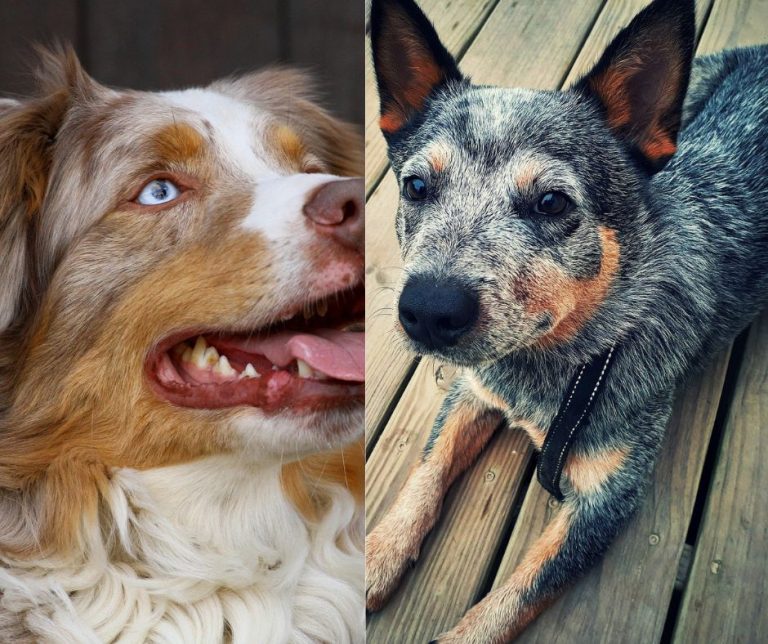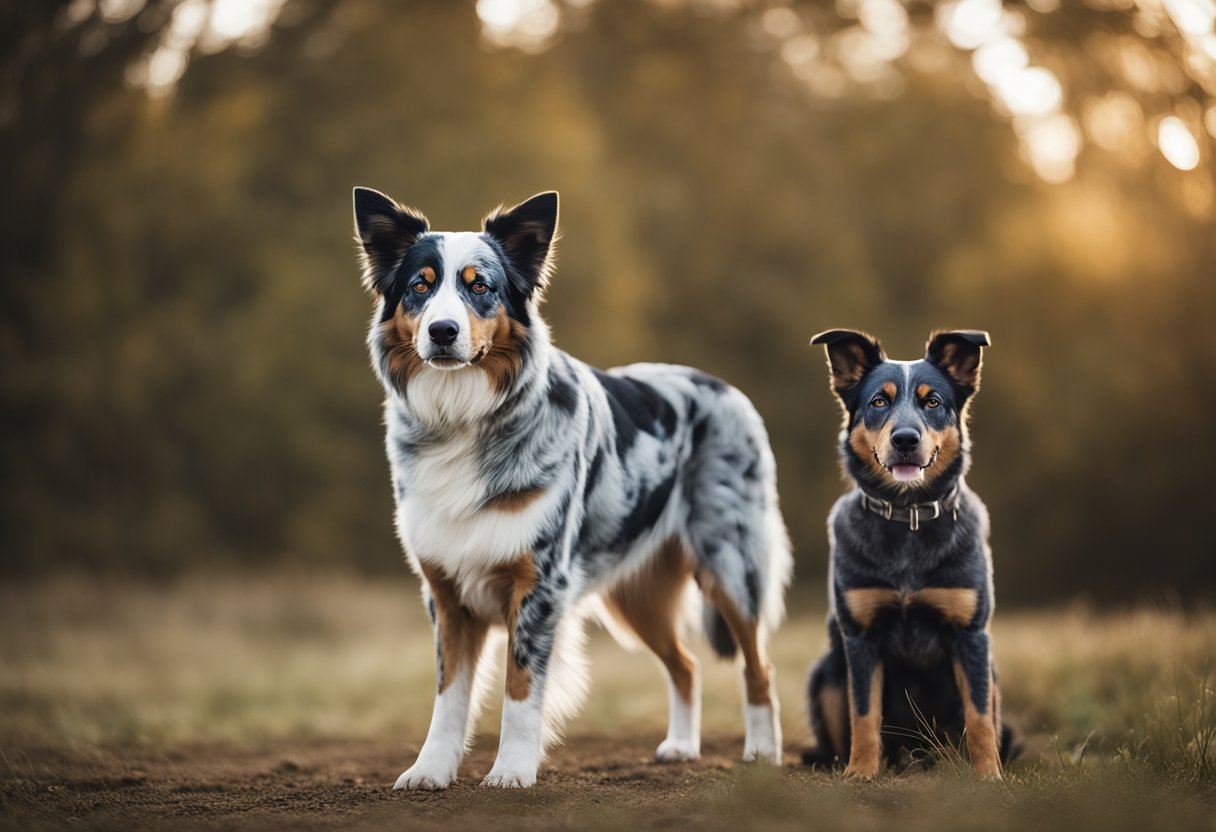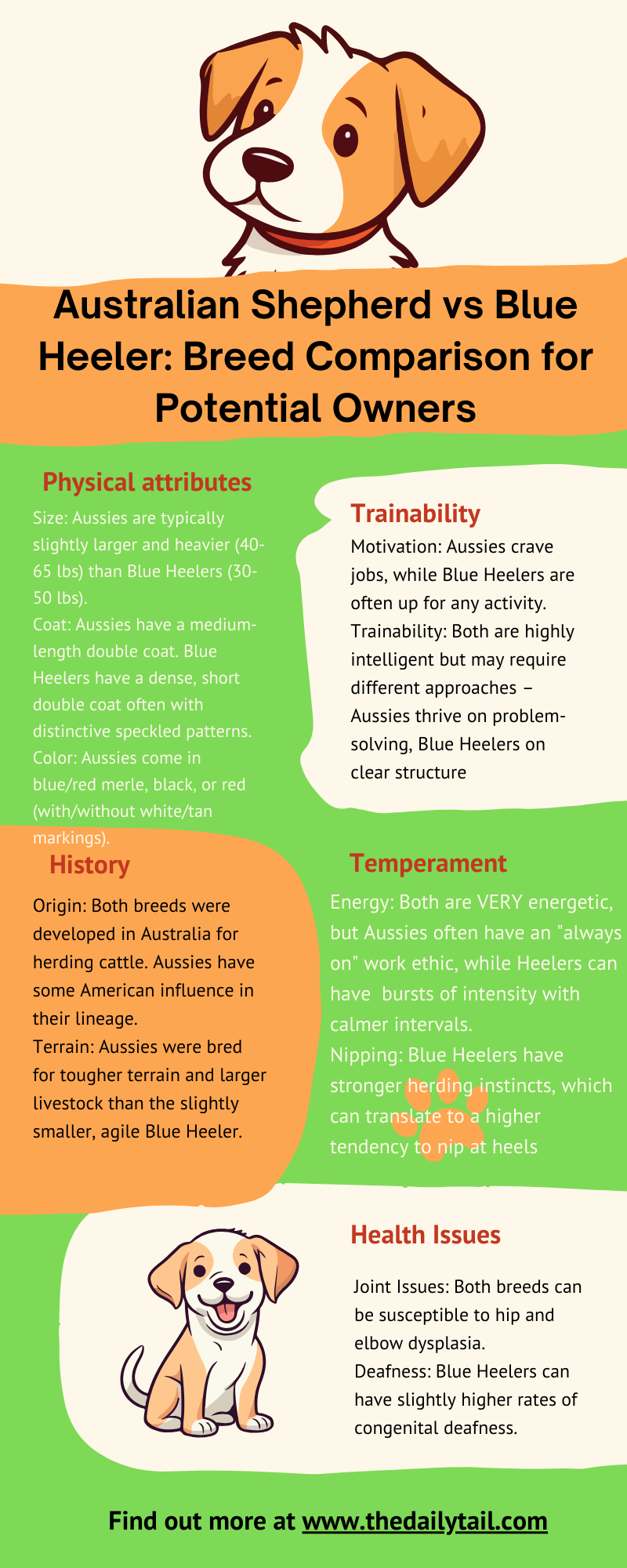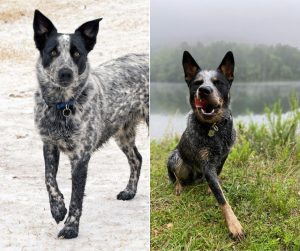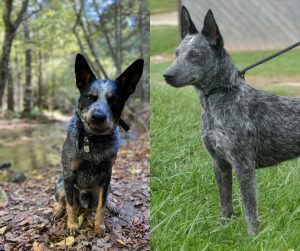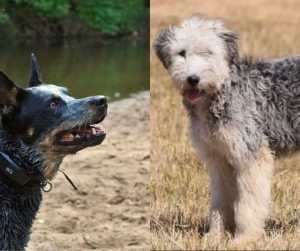Australian Shepherds and Blue Heelers are two of the most recognized herding breeds in the United States, each with a distinct heritage and set of characteristics that make them suited for the meticulous work of managing livestock. Originally bred to herd animals, these dogs have become beloved pets, known for their loyalty and work ethic. While the Australian Shepherd, despite its name, was developed in the United States, the Blue Heeler, also known as the Australian Cattle Dog, originated in Australia where it was bred for the tough job of herding cattle over long distances.
Both breeds exhibit high energy levels and intelligence, traits essential for a working dog. They share a common need for regular exercise and mental stimulation, making them ideal for active families or individuals who are willing to engage with their dog in activities that challenge them physically and mentally. The Australian Shepherd often grows slightly larger than the Blue Heeler, and both breeds sport a coat that can handle various weather conditions, although they differ in appearance and some aspects of grooming.
It’s their temperament and physical attributes that set them apart. The Australian Shepherd is adaptable, agile, and thrives on having a purpose, often excelling in roles that go beyond herding, such as search and rescue or as service animals. On the other hand, the Blue Heeler is known for its incredible stamina and persistence, traits that make it particularly effective at managing larger livestock such as cattle.
While both breeds make excellent companions, understanding their differences is crucial for potential owners to ensure they can provide the right environment and lifestyle that each breed necessitates.
Ever mixed up an Australian Shepherd and a Blue Heeler? After decades with dogs, I understand! Let’s unravel the subtle (and not-so-subtle) differences between these herding powerhouses. Today, we will look at the Australian Shepherd vs Blue Heeler dog breed comparison.
Breed Origins
Understanding the origins of the Australian Shepherd and the Blue Heeler provides insight into their behavioral traits and herding capabilities. These breeds have distinct histories that have shaped their development into the reliable herding dogs known today. They are both part of the herding group classification by the American Kennel Club.
Australian Shepherd Origin
The Australian Shepherd, despite its name, has its origins in the United States. Initially associated with Basque immigrants, these dogs are descendants of European shepherd dogs and Collies. They were refined in America to aid in herding livestock.
Blue Heeler Origin
The Blue Heeler, also known as the Australian Cattle Dog, originated in 19th century Australia. A farmer named Thomas Simpson Hall crossbred dogs with wild Australian dingoes and introduced Collies and Border Collies, resulting in a breed well-equipped for herding cattle across the vast Australian terrain. Depending on the coat color, we can have Red Heeler or Blue Heeler dogs.
Evolution of Herding Breeds
Herding breeds have evolved to develop traits that assist in effectively managing and protecting livestock. The Australian Shepherd and Blue Heeler showcase this evolution through their intelligence, adaptability, and hardworking nature, all of which make them excellent at herding livestock.
Physical Characteristics
In comparing the physical attributes of Australian Shepherds and Blue Heeler dogs, certain key differences can be found in size, coat variations, distinctive features, and health-related traits. Both breeds boast a sturdy and active build that reflects their herding heritage. The breed standard for both dogs is set by the American Kennel Club.
Size Comparison
Australian Shepherd:
- Height: 18-23 inches
- Weight: 40-65 pounds
Blue Heeler:
- Height: 17-20 inches
- Weight: 35-50 pounds
Australian Shepherds and Blue Heelers are both medium-sized dogs. However, Australian Shepherds tend to be slightly larger and heavier, contributing to their ability to handle a variety of tasks within their herding duties, while Blue Heelers are often leaner, built for agility and quick movements.
Coat Variations
Both breeds possess a double coat that suits their outdoor lifestyles, featuring an undercoat that helps with temperature regulation.
Australian Shepherd:
- Coat Colors: Black, blue merle, red, red merle
- Shedding: Moderate to heavy
Blue Heeler:
- Coat Colors: Blue or red speckled with possible dark or tan markings
- Shedding: Moderate
Australian Shepherd dog breed comes in various colors including merle coats, which present a unique mottled pattern. Blue Heelers are typically found in speckled coat patterns that also include different colors in a speckled array.
Distinctive Features
Distinctive Traits of Australian Shepherds:
- Merle coats may affect eye color, leading to heterochromia
- Ears: Typically folded at the tip
Distinctive Traits of Blue Heelers:
- Tail: Typically hangs in a slight curve
- Ears: Generally more erect
Both dogs are muscular and active, with the Australian Shepherd sporting a broader range of coat colors and patterns and the Blue Heeler having a more consistent speckled appearance.
Health Related Traits
Australian Shepherd:
- Life Expectancy: 12-15 years
- Health Concerns: Hip dysplasia, epilepsy, eye problems
Blue Heeler:
- Life Expectancy: 12-16 years
- Health Concerns: Deafness, hip dysplasia
Both breeds share certain health problems like hip dysplasia, but due to their robust genetic pool, they are generally considered to be healthy breeds. Blue Heelers have a slight predisposition to deafness, especially linked with white coat color. Regular vet check-ups are vital to monitor and maintain their well-being.
Behavior and Temperament
Selecting a pet that aligns with an owner’s lifestyle is crucial; the temperament and behavior of a dog breed can significantly impact the fit within a family or work environment. The Australian Shepherd and Blue Heeler are both intelligent, energetic breeds with a loyal temperament, each possessing distinct behavioral traits that cater to different needs in terms of training, social interaction, and working capabilities.
Intelligence and Training
Both breeds are recognized for their high intelligence and trainability. However, they display different responses to training:
- Australian Shepherd: Highly trainable with a keen ability to learn commands quickly. They thrive on positive reinforcement and mental stimulation.
- Blue Heeler: Known for their sharp intellect and resourcefulness. They respond best to consistent, firm training and may exhibit dominant traits if not properly trained.
Energy and Exercise Needs
These breeds share a need for substantial exercise and mental engagement:
- Australian Shepherd:
- Energy Level: High, requires regular, vigorous activity
- Stamina: Excellent, suitable for extended play and work sessions
- Blue Heeler:
- Energy Level: Highly energetic, demands activities that cater to endurance
- Stamina: Strong, capable of staying active and focused for long periods
Social Behavior and Affection
Socialization and affection levels vary between the breeds:
- Australian Shepherd:
- Social Behavior: Friendly and playful; enjoys being involved in family activities
- Affection: Typically affectionate and loving, they make pleasant family pets
- Blue Heeler:
- Social Behavior: Can be reserved; requires early socialization to interact well with children and other pets
- Affection: Loyal to their family, may form a close bond with a single person
Protective and Working Traits
Intrinsic protective instincts and their roles as working dogs differentiate them:
- Australian Shepherd:
- Protective: Can be very protective of their family, making them good watchdogs
- Working Traits: Bred as herding dogs, they have retained the agility and persistence needed for managing livestock
- Blue Heeler:
- Protective: Innately alert and protective, they are excellent watchdogs and may show wariness towards strangers
- Working Traits: Strong herding instinct, especially with cattle, due to their focused and determined nature
Breed Comparisons
When examining Australian Shepherd vs Blue Heeler comparison, one must consider their herding heritage and their differing origins, physical attributes, and temperaments to understand their suitability as companions.
Australian Shepherd vs Blue Heeler
Australian Shepherd:
- Origin: United States
- Size: Typically stands 18-23 inches tall
- Weight: Usually between 40-65 pounds
Blue Heeler (Australian Cattle Dog):
- Origin: Australian Outback
- Size: Typically stands 17-20 inches tall
- Weight: Usually between 35-50 pounds
Similarities:
- Both have strong herding instincts and are intelligent, active breeds suited to work or play that involves tasks and challenges
Differences:
- Australian Shepherds are typically larger
- Blue Heelers tend to have a more sturdy build
Suitability as Family Pets
Australian Shepherd:
- Adaptable to families, good with children
- Need considerable exercise and mental stimulation
Blue Heeler:
- Loyal and protective, making them ideal for families
- Require substantial outdoor activity due to their high energy levels
Considerations for Apartment Living:
- Both breeds may adapt to apartment living if sufficiently exercised, but larger spaces are ideal given their active nature
Common Misconceptions
- The Australian Shepherd is often mistakenly thought to be from Australia due to its name, but it actually originated in the United States
- It is a misconception that both breeds are inherently aggressive; with proper socialization, both are typically well-mannered
Hybrid Breeds and Variations
- Texas Heeler: A mix between an Australian Shepherd and a Blue Heeler
- Variations within breeds include the Blue Heelers, known also as Red Heelers depending on their coat color, and Australian Shepherds with the merle gene, such as the Red Merle Australian Shepherd
Regional Popularity
- In the United States, Australian Shepherds enjoy widespread popularity, though Blue Heelers are also favored, especially in rural settings
- Both breeds, with their robust herding abilities, maintain a strong presence in regions where livestock management is essential, including the Australian Outback for Blue Heelers and various U.S. regions for Australian Shepherds
Care and Management
When considering the care and management of Australian Shepherds and Blue Heelers, one must take into account their grooming demands, exercise requirements, necessary training and socialization, as well as health concerns and typical lifespan. Both breeds being herding dogs, they are energetic and loving pets that require attentive maintenance and structured routines.
Grooming Demands
Australian Shepherds have a fluffy, long, and wavy double coat which tends to shed, especially during seasonal changes. Regular brushing, at least once a week, helps to remove loose hair and maintain coat health. On the other hand, Blue Heelers sport a dense coat that is less prone to heavy shedding. A Blue Heeler dog breed can typically do with less frequent grooming, but both breeds benefit from routine baths and nail trimmings.
Exercise Requirements
These herding dogs are highly energetic with a substantial need for daily exercise to maintain their health and temperament. The stamina of the Australian Shepherd requires rigorous activities like long walks, runs, or agility training. Similarly, a Blue Heeler needs an ample amount of exercise to keep their energy levels balanced. Activities that stimulate their intellect and provide a physical workout are ideal.
Training and Socialization
Training should start early for both breeds as they are intelligent and capable of learning quickly. Australian Shepherds and Blue Heelers respond well to positive reinforcement techniques. Consistent training and patient socialization are crucial as both have strong herding instincts. These dogs need to socialize with various people, pets, and environments to become well-adjusted adults.
Health Concerns and Lifespan
Australian Shepherds and Blue Heelers are generally healthy, but they are susceptible to certain hereditary health problems. Regular veterinary check-ups are vital to catch issues like deafness or epilepsy early on. With proper care, the expected lifespan for an Australian Shepherd can range from 12 to 15 years, while a Blue Heeler may live between 13 and 15 years. Monitoring their health is important as early diagnosis and treatment can improve their quality of life.
Choosing the Right Breed for You
When deciding between an Australian Shepherd and a Blue Heeler, prospective pet owners need to consider their lifestyle, home environment, and the specific needs of each breed.
Considerations for Potential Owners
Lifestyle & Home Environment: Australian Shepherds and Blue Heelers are high-energy herding dogs that require ample space and exercise. They may not be suited for apartment living due to their active nature and herding instinct. Families should consider how much room they have for the dog to run and play. Moreover, both breeds can make excellent family pets with the right training but may have a high herding drive, which requires management around children and other pets.
Allergies & Grooming: Potential owners with allergies should note that both breeds shed and need regular grooming. Australian Shepherds have a longer coat that might collect more allergens, while Blue Heelers have a shorter, more manageable coat.
Watchdog Capabilities: If someone is looking for a loyal watchdog, both breeds can be highly protective and make excellent guardians of the home. They are vigilant and have a natural instinct to protect their family.
Understanding Each Breed’s Needs
Exercise: Australian Shepherds and Blue Heelers need significant daily exercise to maintain their health and happiness. A commitment to activities such as walking, running, or playing fetch is crucial.
| Breed | Exercise Needs |
|---|---|
| Australian Shepherd | High; enjoys activities like agility or frisbee |
| Blue Heeler | High; excels in tasks like herding or obedience trials |
Socialization: Early socialization is vital for both breeds to ensure they are well-adjusted pets. Owners must introduce them to various people, animals, and environments starting at a young age.
Mental Stimulation: They thrive on challenges and tasks that stimulate their minds. Puzzle toys, advanced training, and dog sports are excellent ways to keep these intelligent breeds engaged.
Adopting from Shelters vs Breeders
Shelters: Adopting from a shelter allows potential pet owners to provide a home to a dog in need. Many times, one can find Australian Shepherds and Blue Heelers or their mixes in shelters, and the staff can help match the right dog with an individual’s lifestyle.
Breeders: Those looking for a specific lineage or temperament may choose to adopt from a reputable breeder. It is essential to research breeders thoroughly to ensure they follow ethical breeding practices and provide health clearances.
In summary, both Australian Shepherds and Blue Heelers can make excellent pets for the right owner. It’s crucial to recognize each breed’s needs and to consider personal circumstances when making a choice. Through thoughtful consideration and commitment, either one of these dynamic breeds could become a cherished family pet.

